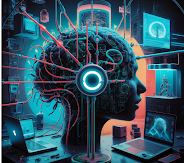Neuromorphic Computing:
Using Human Brain Models to Create Intelligent Machines

In recent years, the demand for smarter, faster, and more energy-efficient computing has led to a major technological shift. Traditional computing architectures, based on the von Neumann model, are being pushed to their limits in handling complex tasks such as artificial intelligence (AI), pattern recognition, and real-time data processing. In response to these challenges, scientists and engineers have turned to a groundbreaking approach known as neuromorphic computing — a field that seeks to emulate the architecture and functioning To innovate more powerful and efficient systems cognitive technology utilizes human brain functions.
What is Neuromorphic Computing?
Neuromorphic computing refers to the design and development of computer systems inspired by the structure, behavior, and functioning of biological neural systems. Unlike conventional computing systems that separate memory and processing units, neuromorphic systems aim to combine these elements, much like how the brain operates. This architecture allows for more parallel processing, adaptive learning, and efficient energy use — crucial traits for next-generation computing.
In the 1980s, Carver Mead coined the word "neuromorphic" to refer to analog circuits that mimic neuro-biological topologies.These days, the phrase refers to hardware, software, and analog and digital systems These all aim to replicate the functions of brain synapses and neurons.
How Does It Work?
Artificial neurons and synapses are used by neuromorphic computers to process data.These artificial components are typically made using novel materials and devices like memristors, which can store and process data simultaneously. Unlike traditional processors that operate sequentially, neuromorphic chips process information in parallel, which allows for faster decision-making and learning.
Spiking neural networks (SNNs) are a crucial component of neuromorphic systems.Unlike traditional artificial neural networks (ANNs) used in deep learning, SNNs transmit information only when a threshold is reached — similar to the brain's action potential mechanism. This “event-driven” approach significantly reduces energy consumption and makes neuromorphic chips highly efficient for tasks such as sensory processing, robotics, and real-time data analysis.
Advantages of Neuromorphic Computing
Energy Efficiency
Traditional AI systems consume massive amounts of power, especially during training and inference. Neuromorphic systems, inspired by the brain’s low-power operation, can perform similar tasks using a fraction of the energy. This makes them ideal for mobile devices, edge computing, and IoT applications where energy resources are limited.
Real-Time Processing
Because of their parallel nature, neuromorphic chips perform exceptionally well in real-time processing. This enables quicker responses, which is vital for applications like autonomous driving, drones, and robotics where split-second decisions are crucial.
Adaptive Learning
Unlike static systems, neuromorphic processors can adapt to new data without retraining from scratch. This allows for continuous learning in changing environments, making them suitable for personalized AI and adaptive control systems.
Noise Tolerance
Neuromorphic systems are inherently robust and can perform well even in noisy or incomplete data conditions, similar to the human brain’s ability to recognize patterns despite distractions.
Key Players and Technologies
Neuromorphic computing is being pioneered by a number of businesses and academic institutes.
The Loihi processor, created by Intel, supports SNNs and includes more than 130,000 artificial neurons.
It enables adaptive learning on-chip, making it a leader in the field.
The TrueNorth chip, a digital neuromorphic semiconductor including 256 million synapses and one million neurons, was unveiled by IBM.
BrainChip and SynSense are startups focused on bringing neuromorphic chips to commercial markets in areas like surveillance, automotive, and wearable devices.
On the academic front, institutions like Stanford University, MIT, and ETH Zurich are actively researching neuromorphic architectures, materials, and software frameworks.
Applications of Neuromorphic Computing
Neuromorphic computing holds promise across various sectors:
Healthcare: Neuromorphic chips can power brain-machine interfaces, detect neurological disorders, and enable smart prosthetics that respond to neural signals.
Autonomous Vehicles: These systems require real-time decision-making, object detection, and navigation tasks where neuromorphic chips outperform traditional processors.
Smart Sensors and IoT: Due to their low energy footprint, neuromorphic chips are ideal for always-on sensors in smart homes, environmental monitoring, and industrial automation.
Defense and Aerospace: The adaptability and speed of neuromorphic systems are well-suited for surveillance, unmanned aerial vehicles (UAVs), and satellite data processing.
Consumer Electronics: Applications in voice assistants, gesture recognition, and augmented reality can benefit from faster and more efficient neuromorphic processing.
Challenges and Limitations
Notwithstanding its promise, neuromorphic computing has a number of obstacles to overcome:
Standardization: It is challenging to compare and assess various neuromorphic systems due to the absence of common standards or benchmarks.
Software Ecosystem: Most AI development is tailored for conventional hardware using tools like TensorFlow and PyTorch.New programming paradigms, tools, and algorithms are needed for neuromorphic systems.
Hardware Complexity: Designing chips that mimic the brain's structure is highly complex and costly. Manufacturing variability in devices like memristors can also affect performance.
Market Readiness: While research is progressing, many neuromorphic systems are still in the prototype or early deployment stages. Large-scale commercial adoption may take years.
The Future of Neuromorphic Computing
The next decade will likely witness significant advancements in neuromorphic technologies. As AI and machine learning continue to expand into everyday life, the need for more brain-like, energy-efficient systems will grow. Hybrid systems combining traditional and neuromorphic architectures may emerge, optimizing performance based on task requirements.
Furthermore, integration with quantum computing, nanotechnology, and brain-inspired algorithms could open up new frontiers in cognitive computing, pushing the boundaries of machine intelligence.
Additionally, neuromorphic computing may help us comprehend the brain.By attempting to replicate neural behavior in silicon, researchers can develop models that offer insights into cognition, memory, and learning potentially aiding neuroscience and medicine.
Conclusion
A revolutionary change in the way machines process information is represented by neuromorphic computing.
By mimicking the architecture and efficiency of the human brain, it offers a path toward more intelligent, adaptive, and energy-efficient systems. While challenges remain, ongoing research and innovation suggest a promising future where neuromorphic systems play a central role in shaping the next generation of computing.









0 Comments